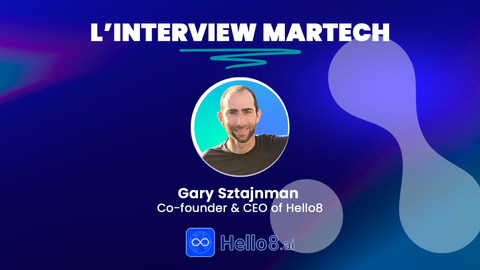Four years ago, we questioned the long-term use cases of chatbots following the hype of 2016–2017.
The first wave of chatbots was accompanied by highly ambitious promises that generated significant enthusiasm. However, this initial wave was hampered by technical limitations, leading to disappointment. Marketing professionals quickly realized the shortcomings of chatbots in handling complex requests, often requiring human intervention to provide appropriate responses.
Today, fueled by the rise of generative AI, chatbots have evolved far beyond their status as a promising tool to become an essential part of the Martech landscape—provided they are used effectively. They now unquestionably enable businesses to maximize operational efficiency while enhancing the customer experience.
A booming market
The global chatbot market is projected to reach an estimated $15.5 billion by 2028, with increasing adoption across sectors such as healthcare, finance, and e-commerce.
Today, more than 1.5 billion people use chatbots, particularly for customer support and sales assistance. Companies are seeing significant savings: up to 2.5 billion work hours saved in 2023 thanks to these technologies (sources: Business Research Insights, Springs Apps).
A revolution powered by artificial intelligence

What has truly changed since their inception? Chatbots are no longer limited to simple scripted responses. Thanks to artificial intelligence (AI), and especially natural language processing (NLP), these SaaS tools can now finely adapt to businesses’ specific needs. They can interpret intent, context, and even emotion, enabling more personalized and seamless interactions.
This progress makes chatbots a key asset for companies aiming to differentiate themselves through superior customer relationships.
SaaS tools for increasingly diverse use cases
One of the major advantages of today’s chatbots is their flexibility, largely thanks to the precision enabled by AI. They support a wide range of use cases:
- Commerce and e-commerce: Chatbots play a pivotal role in lead generation by welcoming website visitors and qualifying their needs in real time. By recommending tailored products, they increase conversion rates.
For example, H&M uses a chatbot on Kik to provide personalized outfit recommendations. After answering a few preference questions, customers receive suggestions aligned with their tastes, boosting conversion potential. - Customer service (after-sales): Chatbots are ideal for resolving frequently asked questions or handling simple complaints, reducing customer wait times and freeing up human teams.
For instance, Amazon’s chatbot within Alexa handles common queries such as order tracking and issue resolution, offering 24/7 assistance. - Internal support: Chatbots also streamline employee onboarding and handle recurring IT or HR requests within organizations.
IBM Watson assists employees through an internal chatbot capable of answering questions about HR processes, training, or internal tools. This results in smoother onboarding and quicker operational query resolution. - Personalized marketing: By leveraging user data, chatbots can deploy highly targeted campaigns, increasing engagement.
For example, Estée Lauder’s chatbot uses Facebook data (like users’ photos) to recommend personalized cosmetic products, such as foundation shades, enhancing personalization and driving in-store visits.
Proven results across use cases
-
Commerce and e-commerce: At Botmind, chatbot automation reduced average customer query handling time by 47%, increased customer satisfaction by 27%, and lowered operational costs. According to a Shopify study, in 2023, around 60% of consumers reported that chatbots saved them time, particularly when completing online purchases. Companies using chatbots have seen reduced cart abandonment and significant increases in conversion rates.
-
Customer service: According to HubSpot, Sephora’s chatbot Ora automated 20% of requests within just a few weeks, maintaining high customer satisfaction through smooth handovers to human agents. The outcome: reduced customer support costs and happy customers.
-
Internal support: Data from Jacadi shows that companies using chatbots for onboarding and internal support save up to 119 work hours per month.
-
Marketing
According to HubSpot, Okta, a leader in identity and access management, doubled its qualified lead conversion rate with a personalized chatbot integrated into its sales process. Powered by Drift Conversational AI, the chatbot enhanced customer engagement on the website by qualifying leads, answering FAQs, and booking meetings directly with the sales team.
Companies using chatbots as SaaS tools report clear benefits:
-
Cost optimization: By automating repetitive tasks, chatbots reduce operational expenses.
-
Improved customer satisfaction: Available 24/7, they provide immediate and consistent support.
-
Revenue growth: By guiding prospects and encouraging impulse purchases, chatbots boost sales.
What’s next: perspectives and innovations
The chatbot market is witnessing a wave of innovations:
-
Voice chatbots: Inspired by technologies like Siri and Alexa, these add an interactive layer that aligns with user preferences.
-
Integration with payment systems: Chatbots are facilitating transactions, unlocking new e-commerce opportunities.
-
Social media integration: Increasingly deployed on these platforms, chatbots are enhancing customer engagement.
The growing role of AI is also expanding possibilities with hybrid and customized solutions. The major innovation today lies in hybrid chatbots, combining rule-based responses with machine learning. These intelligent SaaS tools deliver the best of both worlds: precision and adaptability.
Moreover, tailored solutions are emerging, allowing businesses to configure chatbots to address their sector-specific needs—whether in healthcare, finance, or retail.
Towards widespread chatbot adoption?
SaaS solutions are making chatbots accessible to businesses of all sizes. These platforms enable fast, scalable integration without requiring heavy technical investment. Regular updates ensure that chatbots remain at the forefront of technological innovation.
Thanks to their cloud-based model, SaaS chatbots offer unparalleled scalability. Companies can start small and expand gradually based on their evolving needs.
With the rise of platforms like OpenAI, Dialogflow, and HubSpot, chatbot creation and management have become accessible even to non-technical users. These SaaS tools provide user-friendly interfaces for easy chatbot customization, while ensuring seamless integration with existing systems (CRM, ERP, etc.).
In 2024, chatbots have reached maturity and can now be considered a core pillar of marketing strategies. They embody the promise of SaaS tools by combining accessibility, personalization, and efficiency. For businesses, the challenge now lies in selecting the solution that best aligns with their goals.
Conclusion
With an estimated annual growth rate of 37%, chatbots continue to reshape the digital landscape for businesses, offering ever more efficient and cost-effective automation (sources: Business Research Insights, Conversationnel, Smart Tribune).
The advances of generative AI have confirmed that what was merely a trend in 2018 has now become a lasting revolution in customer relationship management, positioning SaaS tools as a vital lever for digital transformation.
However, despite the impressive progress of generative AI, it does not enable full automation of these processes. Dedicated teams are still needed to manage and optimize workflows around these new “agents.”
At Saas Advisor, our certified experts support you in implementing your chatbot to help you quickly and effectively achieve your business objectives.





